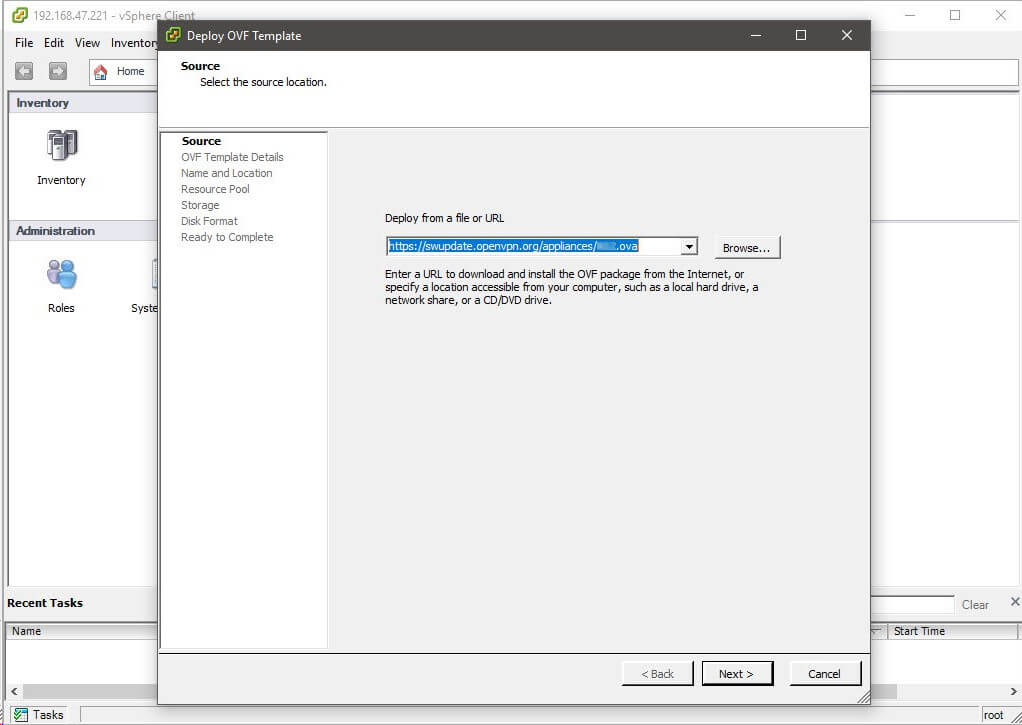
- #Deploy ovf vmware work install#
- #Deploy ovf vmware work registration#
- #Deploy ovf vmware work software#
- #Deploy ovf vmware work plus#
- #Deploy ovf vmware work free#
You can create the Site Recovery replication appliance by using the OVF template or through PowerShell. Create Azure Site Recovery replication appliance
#Deploy ovf vmware work software#
Ensure you meet all the hardware and software requirements, and any other prerequisites. To set up a new appliance, you can use an OVF template (recommended) or PowerShell. Prepare Infrastructure and proceed with the sections detailed below: Go to Recovery Services Vault > Getting Started. For detailed information on the operations performed by the appliance see this section You need to set up an Azure Site Recovery replication appliance in the on-premises environment to enable recovery on your on premises machine.
#Deploy ovf vmware work registration#
Alternately, the tenant/global admin can assign the Application Developer role to an account to allow the registration of AAD App.

In case the App registrations settings is set to No, request the tenant/global admin to assign the required permission. In User settings, verify that Azure AD users can register applications (set to Yes by default). In Azure portal, navigate to Azure Active Directory > Users > User Settings. To register the appliance, your Azure account needs permissions to register AAD apps.įollow these steps to assign required permissions: In Add a role assignment, select Add, select the Contributor or Owner role, and select the account. In Check access, search for the relevant user account. In the selected subscription, select Access control (IAM) > Check access. In the Subscriptions page, select the subscription in which you created the Recovery Services vault. In the Azure portal, search for Subscriptions, and under Services, select Subscriptions search box to search for the Azure subscription. Here are the required key vault permissions:įollow these steps to assign the required permissions: If you're not the subscription owner, work with the owner for the required permissions.
#Deploy ovf vmware work free#
If you just created a free Azure account, you're the owner of your subscription.
#Deploy ovf vmware work plus#
#Deploy ovf vmware work install#
Folder exclusions from Antivirus program If Antivirus Software is active on applianceĮxclude following folders from Antivirus software for smooth replication and to avoid connectivity issues.Ĭ:\Program Files\Microsoft Azure Appliance Auto UpdateĬ:\Program Files\Microsoft Azure Appliance Configuration ManagerĬ:\Program Files\Microsoft Azure Push Install AgentĬ:\Program Files\Microsoft Azure RCM Proxy AgentĬ:\Program Files\Microsoft Azure Recovery Services AgentĬ:\Program Files\Microsoft Azure Server Discovery ServiceĬ:\Program Files\Microsoft Azure Site Recovery Process ServerĬ:\Program Files\Microsoft Azure Site Recovery ProviderĬ:\Program Files\Microsoft Azure to On-Premise Reprotect agentĬ:\Program Files\Microsoft Azure VMware Discovery ServiceĬ:\Program Files\Microsoft On-Premise to Azure Replication agent Private links are not supported with the preview release. Upload data to Azure storage which is used to create target disks. Used for Azure Site Recovery appliance updates.Ĭommunication between the appliance and the Azure Site Recovery service.Ĭonnect to Azure Site Recovery micro-service URLs.

Note: Ensure machines to replicate have access to this.Īllow access to also known as links.

Upload app logs used for internal monitoring. VMXNET3 (if the appliance is a VMware VM)Įnsure the following URLs are allowed and reachable from the Azure Site Recovery replication appliance for continuous connectivity: URLĬreate Azure Active Directory (AD) apps for the appliance to communicate with Azure Site Recovery.Ĭreate Azure AD apps for the appliance to communicate with the Azure Site Recovery service. No pre-existing website/application listening on port 443įIPS (Federal Information Processing Standards) Prevent access to registry editing tools.


 0 kommentar(er)
0 kommentar(er)
